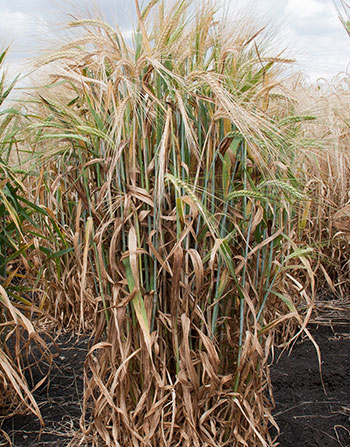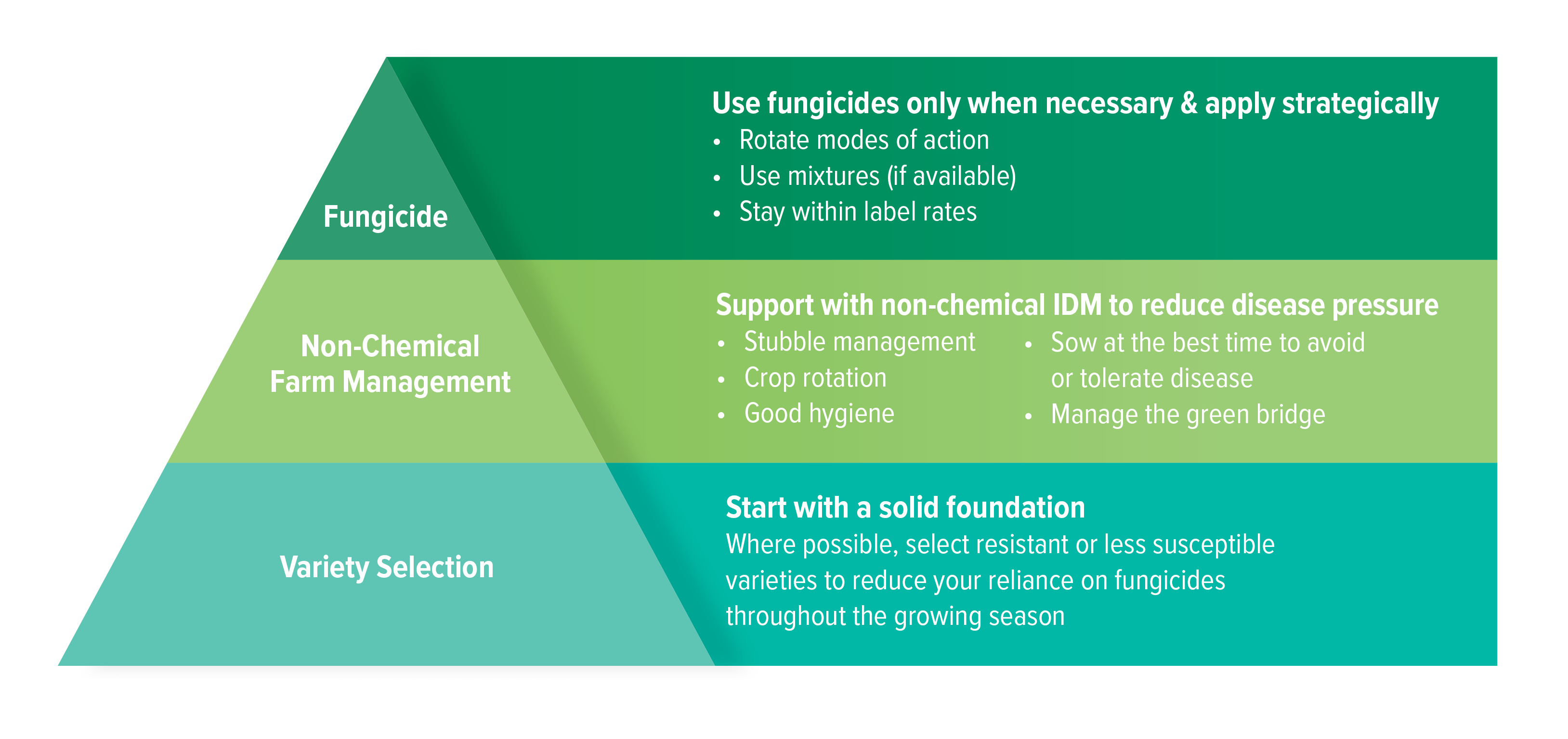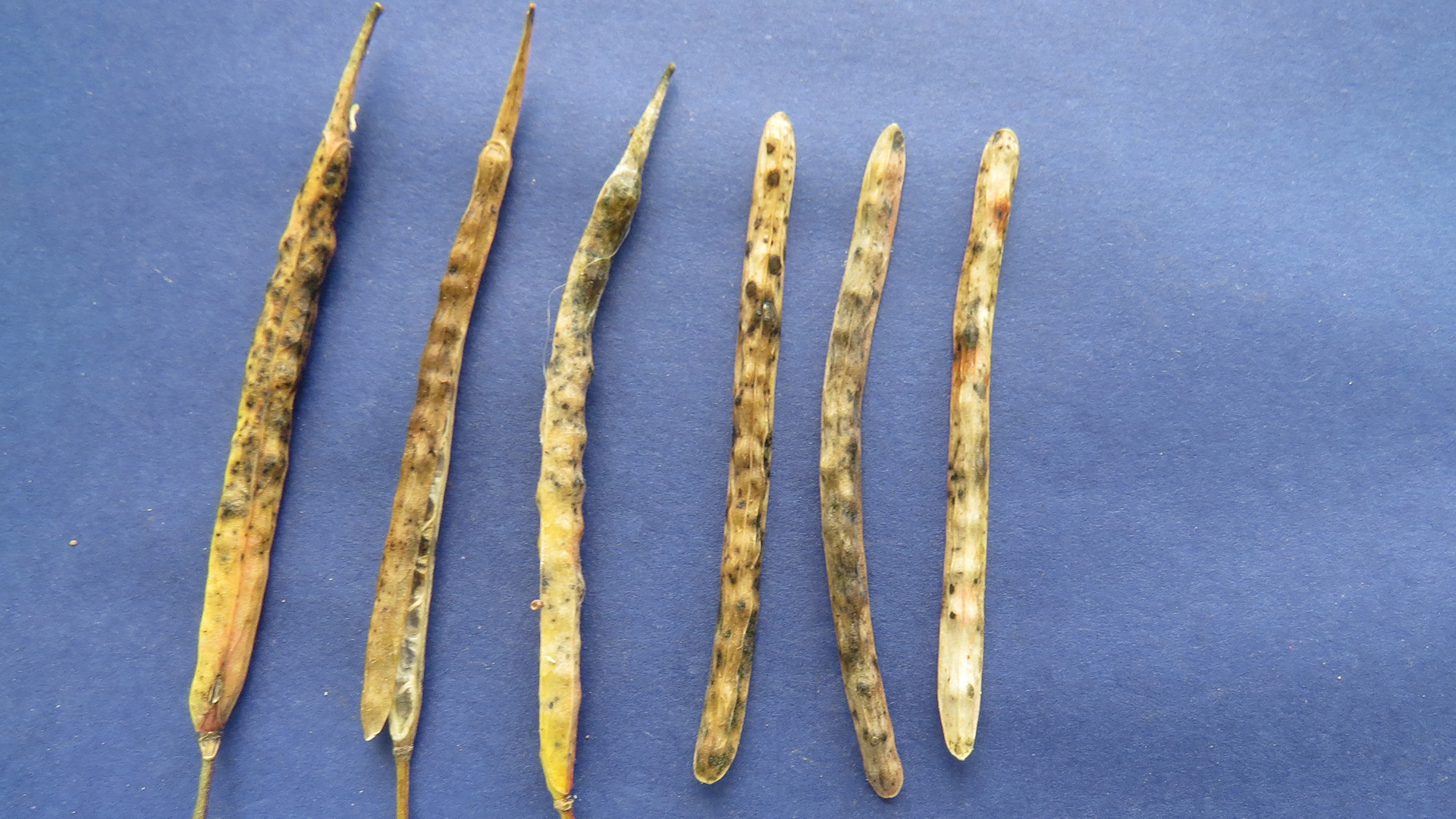Paddock Practices: Variety selections for fungal disease management in 2023
Paddock Practices: Variety selections for fungal disease management in 2023
Date: 06 Dec 2022

A high incidence of fungal disease in Western Australia’s Albany and Esperance Port Zones during the 2022 season has led to increased concerns about fungicide resistance, with attention now turning to which crops and varieties will offer better genetic disease resistance for next season.
In particular, growers have reported significant levels of net form net blotch (NFNB) in barley and wheat powdery mildew (WPM). Blackleg of canola, while generally well-managed, is also a concern as the area planted to canola increases.
Is it fungicide resistance?
Fungicide resistance expert at Curtin University’s Centre for Crop Disease Management (CCDM), Associate Professor Fran Lopez-Ruiz, welcomes the increased awareness and concern regarding fungicide resistance.
However, he attributes most difficulties with fungicide effectiveness during 2022 to high disease levels simply overwhelming the controlling effect of chemical applications. The fact that wheat, barley and canola crops were all affected reinforces this view.
Additionally, he says widespread WPM pathotypes with reduced sensitivity or resistance to Group 3 Demethylation Inhibitor (DMI) and Group 11 Quinone outside Inhibitor (QoI) chemistries in the eastern states highlights the need to follow sound disease and fungicide management practices.
However, Assoc Prof Lopez-Ruiz says WA has managed to avoid fungicide resistance in WPM so far, unlike the situation for net blotches.
“WPM is a sporadic disease and this year saw substantial outbreaks which can appear alarming after a few seasons with relatively low levels of the disease,” he says.
“In contrast, NFNB with reduced sensitivity to Group 3 DMI fungicides is widespread in the high-rainfall zone (HRZ) of WA but cases of full resistance have been limited to distinct pockets and the number of cases has remained stable.
“We are detecting more resistance to Group 7 Succinate Dehydrogenase Inhibitor (SDHI) fungicides in spot form net blotch (SFNB) and that appears to be spreading. It is possible this loss of sensitivity is being encouraged by the widespread use of SDHI seed treatments and the increase in SDHI foliar treatments.”
As part of its crop surveillance program (GRDC project DAW2104-003RTX), the Department of Primary Industries and Regional Development, Western Australia (DPIRD) submits samples from the Esperance Port Zone each year. DPIRD research scientist Andrea Hills reports that of the WPM submissions, none have shown any mutation for fungicide resistance to date.
Use crop and variety rotation to discourage disease
Assoc Prof Lopez-Ruiz says the frequency of NFNB in barley crops further north shows how variety rotation can help growers control disease.
CCDM does regular NFNB surveys in the Great Southern and detected much lower rates of disease than expected last season, despite wet conditions and heavy crop canopies.
Assoc Prof Lopez-Ruiz suspects this is due to growers planting a range of barley varieties, which provides a more dynamic host environment.
“Uncontrollable NFNB seems to be more of a problem with RGT Planet in the Albany and Esperance Port Zones,” he says.
“The NFNB population in those areas has adapted to RGT Planet over several years.”

The timing of fungicide applications has a significant impact on their effectiveness and fungicides should be applied at the first sign of disease if conditions are forecast to favour disease development. Should a large outbreak be allowed to develop, fungicides may fail to provide the level or duration of control expected, even at the maximum label rate.
“I think the level of disease pressure in the 2022 growing season is what caused many growers to experience disappointing performance from their fungicide applications,” Assoc Prof Lopez-Ruiz says.
He encourages growers to consider fungicide as their ‘disease control of last resort’ and to use all other agronomic tools at their disposal to minimise disease pressure.
“The key element in fungal disease control is still crop rotation, with enough time between similar rotations for stubble and its inoculum load to break down before a repeat crop is established.
“Changing to more resistant varieties will also help but it is essential to maintain a dynamic host environment and not just keep planting the new variety for several years as happened with RGT Planet in some areas.
“If we do that, the disease will adapt faster than the breeders can deliver improved varieties.”
Repeated plantings add risk
DPIRD plant pathologist Geoff Thomas confirms that rotating varieties is an essential tactic.
“A small number of wheat and barley varieties dominate in the WA’s high-rainfall zone, with most growers sowing RGT Planet barley and Scepter wheat year after year,” he says.
“Both have leading yield potential, but RGT Planet’s NFNB rating has been shifting towards susceptible and there is definitely a RGT Planet-virulent pathotype present in the Albany and Esperance region.”
Mr Thomas says the situation with wheat varieties in the region is similar, with Scepter continuing to dominate planting programs despite it being considered susceptible to WPM. Alternative varieties may offer slightly better resistance, but most are still considered susceptible.
“If you look at the Australian Fungicide Resistance Extension Network (AFREN) triangle for managing fungicide resistance (Figure 1), varietal resistance is the bottom layer,” Mr Thomas says.
“It is the foundation that supports other strategies, including non-chemical disease prevention and fungicide use. If you undermine that foundation layer, everything else is put under pressure.”
He considers this to be the key to problems with fungal disease around Albany and Esperance in 2022.
“NFNB has been given repeated opportunities to adapt to RGT Planet,” he adds.
“When local adaptation was combined with high carry-over inoculum loads and conducive conditions, the diseases took off to a level where they could out-pace the fungicide applications.”

Review 2023 variety choices
Rather than naming specific barley or wheat varieties as replacements for RGT Planet and Scepter, Mr Thomas recommends knowing the strengths and weaknesses of relevant varieties.
“Start with the 2023 WA Crop Sowing Guide then discuss the options with an adviser who has local experience and knows how newer varieties have performed in local trials or plantings,” he says.
“Talking to an expert can provide extra insight into how each variety responds to the local growing conditions, inoculum loads and disease pressures.”
Reviewing potential variety selections for the coming season and practicing non-chemical disease management practices – including crop rotations to control the carry-over disease risk and changing varieties more frequently to slow pathotype adaptation – should help reduce the likelihood of uncontrollable disease outbreaks in the future.
“We know diseases have been in the paddocks at extremely high levels and they will leave high inoculum loads on the stubble,” Mr Thomas says.
“If a paddock has a high level of NFNB that thrives on RGT Planet, or WPM that thrives on Scepter, planting those varieties again is the perfect set-up for another bad disease outbreak.”
Growers are also advised to consider the full economic cost of planting the highest-yielding variety versus a more resistant option when making their varietal choices for 2023 and beyond.
The cost of several high-concentration fungicide applications and yield losses from disease may make a top-yielding variety less profitable than an alternative with more modest yield potential but better disease resistance and lower input costs.

Limit blackleg impact
For canola growers, blackleg was also a concern in 2022.
DPIRD plant pathologist Andrea Hills is based at Esperance. She reiterates that any lack of effect from fungicides was almost certainly due to heavy spore showers coinciding with seedling emergence and an extended wet spring – rather than reduced sensitivity or resistance.
“A lot of canola has been planted in the area over the last few seasons, which increases the inoculum level in the system and reduces rotation time between canola crops,” she says.
“The wet conditions really gave it a good year and those high inoculum loads will remain on the stubble for 2023.”
The blackleg pathogen adapts quickly to genetic resistance in canola varieties and rotating varieties from different resistance groups is key to keeping blackleg levels low.
The GRDC Blackleg Management Guide and the BlacklegCM decision tool are essential sources of information for selecting canola cultivars by their resistance grouping and assessing other risk factors. The Blackleg Management Guide recommends inspecting canola for crown cankers at the end of every season and changing to a variety from a different resistance group if the disease appears to be gaining ground.
“Growers in the Esperance Port Zone like open-pollinated canola for seed production but there is a high risk of resistance breakdown if the same variety is grown and sown more than three years in a row,” Ms Hills says.
“Choosing a variety with major effective gene resistance will also provide good protection against upper canopy infection (UCI) of blackleg, although that will decline over time.
“It is imperative not to plant canola into last year’s canola stubble and to provide good distance between each year’s plantings of the same variety.”
Along with regular crop and variety rotations, time of sowing will support blackleg control. Early sowing reduces the risk of crown cankers, especially when combined with a fungicide seed treatment. However early sowing increases the risk of UCI if the crop starts flowering in June or July.
“UCI is unlikely to cause a yield loss in a crop that flowers from August, so early sowing should be combined with a slow maturing variety to avoid flowering in July,” Ms Hills says.
“If UCI occurs, fungicide may not provide an economic benefit where projected yields are less than 2.0 tonnes per hectare.
“Growers in the HRZ can achieve higher yields and should use the UCI BlacklegCM app to determine if spraying will provide a benefit.”
Canola guidelines show how cereal disease can be managed
Australia’s canola industry has not suffered any major blackleg losses for more than two decades, despite the highly virulent and mutable nature of the pathogen.
Regular variety rotation coupled with integrated disease management and strategic fungicide use have all helped contain the disease, despite an exponential increase in plantings and inoculum loads.
For disease-wary growers in the Albany and Esperance Port Zones, the guidelines for canola could well be applied to their barley and wheat variety programs for future seasons.
Concerned about fungicide resistance?
Fungicide resistance is a serious issue and taking an integrated approach to disease management offers growers the best strategy for limiting the impact of disease and avoiding practices that encourage resistance.
The Australian Fungicide Resistance Extension Network (AFREN) website includes recommendations and resources for disease management and sustainable fungicide use, starting with selecting resistant varieties and following sound crop rotation practices to reduce the existing inoculum load in paddocks.
It also provides contact information for a national network of fungicide resistance experts, who can advise agronomists on local resistance cases, risk factors and next steps if fungicide resistance is suspected.
This paddock practices article was produced by the Grains Research and Development Corporation (GRDC) with input from the Centre for Crop and Disease Management (CCDM) and the Department of Primary Industries and Regional Development (DPIRD) Western Australia.
More information
Fran Lopez-Ruiz, CCDM, fran.lopezruiz@curtin.edu.au
Geoff Thomas, DPIRD WA – South Perth, geoff.j.thomas@dpird.wa.gov.au
Andrea Hills, DPIRD WA - Esperance, andrea.hills@dpird.wa.gov.au
Useful Resources
DPIRD 2023 Western Australia Crop Sowing Guide
GRDC Blackleg Management Guide
Australian Fungicide Resistance Extension Network (AFREN) – Resources, and contacts for fungicide use, fungicide resistance risks and disease management.
Further Reading
GRDC Groundcover Co-innovation to curb barley blotches(July-August 2022)
GRDC Groundcover Net blotch fungicide resistance profiling enriches knowledge base(July-August 2022)
